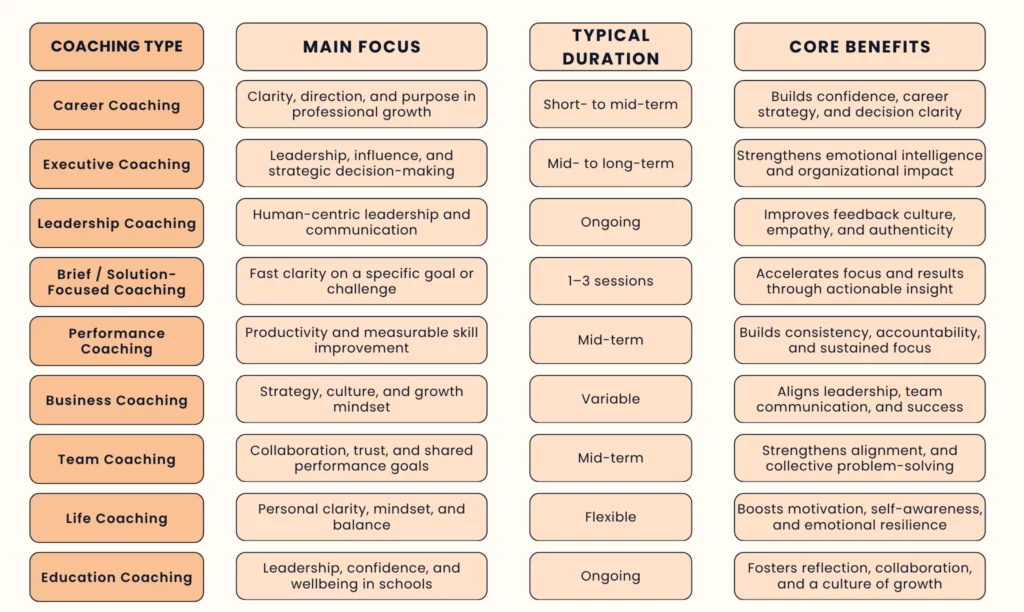
Coaching sounds inspiring – growth, clarity, accountability – but what does it really look like in action?
Sometimes it’s one honest conversation that shifts a mindset. Other times, it’s months of reflection that reshape how an entire team works together. Below are real stories from around the world showing how coaching changes people, teams, and organizations; one goal, one step, one breakthrough at a time.
Because while mentoring shares wisdom from experience, coaching helps people uncover their own, that’s the difference between mentoring and coaching.
Career Coaching
Career coaching helps people find clarity about where they are and where they want to go. It’s ideal for those navigating change, exploring new directions, or trying to bring purpose back into their work life.
It’s not about following someone else’s playbook. It’s about understanding what success really means to you and designing your own path toward it.
Best for:
- Professionals considering a career change or promotion
- Individuals looking for meaning and direction
- Early-career employees setting strong foundations
- Anyone who feels stuck or uncertain about their next step
Helps you:
- Identify strengths, values, and priorities
- Turn vague ideas into specific action steps
- Build confidence in transitions and interviews
- Create a long-term plan that actually feels right
Real-life example:
In Leadership Coaching: From Technical Expert to Inspirational Guide, Emil, an IT team leader, realized that being “good at his job” wasn’t enough anymore. Coaching helped him shift from managing tasks to inspiring people, developing empathy, and finding his own leadership style.
Why it works:
Unlike career mentoring, which focuses on guidance through shared experience, career coaching reconnects people with their “why.” It turns uncertainty into purpose and helps professionals lead their own growth, not just follow it.
Executive Coaching
Executive coaching is for leaders who want to grow beyond strategy and numbers. It’s about building self-awareness, empathy, and focus, the kind of leadership that creates trust and momentum across an organization.
Best for:
- Executives, founders, or senior managers
- Leaders navigating major change or pressure
- Professionals seeking clarity in high-stakes decisions
Helps you:
- Communicate with empathy and influence
- Strengthen confidence and emotional intelligence
- Build alignment and accountability within teams
Real-life example:
In Regina Miles’ Executive Coaching Case Study, a healthcare executive learned to lead with empathy instead of control. Through coaching, she built trust across departments, improved communication, and reshaped her team culture from the inside out.
Why it works:
Executive coaching creates space for reflection. It helps leaders slow down, listen better, and make decisions with clarity instead of pressure.
Leadership Coaching
Leadership coaching focuses on the human side of leadership; vision, resilience, empathy, and trust. It’s what turns good managers into people others actually want to follow.
Best for:
- New managers finding their leadership voice
- Teams navigating big changes
- Organizations focused on people-first leadership
Helps you:
- Communicate clearly and lead with confidence
- Handle feedback and delegation with empathy
- Build strong relationships across teams
Real-life example:
At Defense Acquisition University (DAU), internal coaching programs boosted collaboration, time management, and engagement, with a remarkable 743% return on investment.
Why it works:
Great leaders aren’t just born from experience, they’re shaped by reflection, awareness, and growth. While leadership mentoring often focuses on passing down lessons from those who’ve led before, leadership coaching helps people uncover their own authentic style. Because leadership isn’t about control, it’s about connection, coaching gives leaders the self-awareness and presence to inspire rather than instruct.
Brief or Solution-Focused Coaching
Not all coaching needs months. Sometimes you just need a short, focused push to find clarity fast.
Best for:
- Professionals facing urgent challenges
- Leaders preparing for key meetings or decisions
- People needing direction in a short time
Helps you:
- Get clear on the real issue
- Find practical solutions fast
- Build momentum and confidence
Real-life example:
In Hector Sandoval’s Brief Coaching Case Study, a studio head transformed his communication style in just three sessions. With focused reflection, he learned to influence with confidence and manage pressure more effectively.
Why it works:
Because the distinct difference between flash mentoring and brief coaching is depth over direction, mentoring offers quick advice, while coaching sparks focused reflection that leads to action. Sometimes, small shifts create big impact. Brief coaching cuts the noise and gets right to what matters.
Performance Coaching
Performance coaching helps people work smarter, not harder. It’s about building consistent habits, focus, and accountability that lead to measurable results.
Best for:
- Professionals aiming to improve effectiveness
- Teams seeking structure and motivation
- Managers driving consistent performance
Helps you:
- Identify habits that block progress
- Build focus and resilience
- Set measurable goals and track real progress
Real-life example:
In Executive Coaching Success Stories, leaders improved focus and decision-making through structured reflection and energy management, achieving results within weeks.
Why it works:
Performance coaching is action in motion. It helps people see progress quickly and sustain it over time.
Business Coaching
Business coaching is where leadership meets strategy. It helps entrepreneurs and teams solve challenges, grow sustainably, and build a healthy culture that lasts.
Best for:
- Founders and small business owners
- Teams scaling up or redefining goals
- Organizations aligning around strategy and growth
Helps you:
- Strengthen decision-making
- Improve collaboration and communication
- Identify opportunities for growth
- Build systems that scale
Real-life example:
In 5 Real Examples of Coaching-Based Leadership, a sales leader introduced coaching conversations into her team’s routine. The result: higher engagement, better client relationships, and record-breaking results.
Why it works:
Because it’s not just about profit, it’s about people. Business coaching creates leaders who know how to grow both their company and their team.
Team Coaching
Team coaching helps people think, communicate, and succeed together. It’s not training, it’s transformation through collaboration.
Best for:
- Cross-functional teams struggling with alignment
- Leadership teams navigating change
- Groups needing better communication and trust
Helps you:
- Strengthen trust and transparency
- Improve collaboration and feedback
- Create shared ownership and accountability
Real-life example:
At Spark Success Coaching, an executive team used coaching to rebuild trust after a major restructure. Within months, they had stronger collaboration, clear roles, and a renewed sense of shared purpose.
Why it works:
Because teams don’t just need goals, they need connection. Team coaching helps people move from working side by side to working together.

Life Coaching
Life coaching helps you rediscover purpose and direction when you feel stuck or disconnected. It’s about self-awareness, balance, and turning insight into action.
Best for:
- People seeking clarity and motivation
- Professionals dealing with burnout or transitions
Helps you:
- Clarify what truly matters
- Build confidence and inner balance
- Create meaningful, realistic goals
Real-life example:
In Writing Impactful Case Studies: The Essential Guide for Coaches, coach Joshua McCormick described a client who moved from confusion to clarity by identifying personal values, setting priorities, and following through with accountability.
Why it works:
Because life coaching bridges knowing and doing. It helps people move from “I want to change” to “I am changing.”
Education Coaching
Education coaching gives teachers and school leaders the tools to grow with confidence and balance. It builds reflection, communication, and a stronger sense of purpose, both in and outside the classroom.
Best for:
- Teachers, principals, and school staff
- Institutions aiming to improve collaboration and wellbeing
Helps you:
- Build resilience and confidence
- Improve communication and teamwork
- Foster a culture of learning and trust
Real-life example:
In The Power of Coaching in Education, headteachers Louise Gohr and Helen Morris turned coaching into a shared practice across 15 schools. Staff grew more confident, motivated, and connected, and students felt the difference too.
Why it works:
When educators thrive, students thrive. Coaching helps schools become communities that never stop learning.
Coaching is about achieving growth in all areas of life. It diminishes self-doubt, empowers you to reach your full potential, and helps you capitalise on your strengths.
Claire, Teacher at Pikemere Primary School
Key Takeaway
There’s no single formula for growth, and that’s the beauty of coaching. It meets you where you are and helps you build what comes next. Whether it’s a CEO building empathy, a teacher rediscovering confidence, or a team learning to collaborate again, coaching brings structure, reflection, and action together.
With the right platform, organizations can blend multiple coaching programs seamlessly, supporting every kind of growth in one place. See how Mentorink helps you combine mentoring and coaching in one platform.


